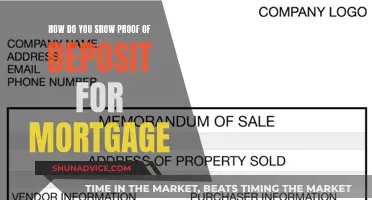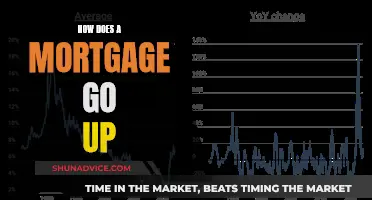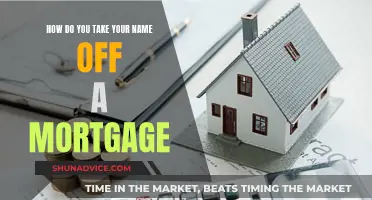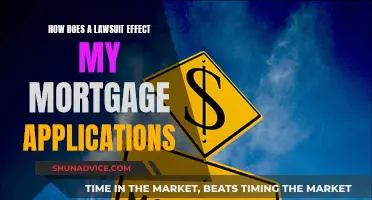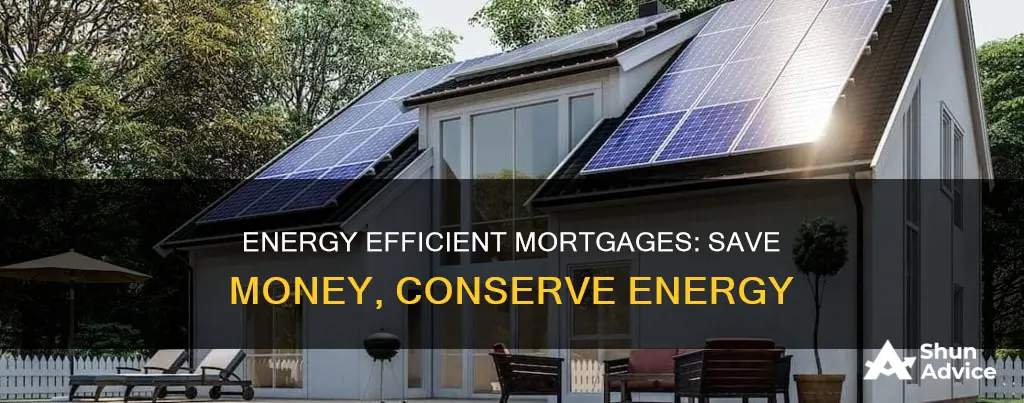
Energy-efficient mortgages (EEMs) are a type of loan product that allows current and prospective homeowners to finance energy-efficient upgrades in new and existing homes. EEMs are also known as green mortgages and can be used to purchase or refinance a home that is already energy-efficient or to purchase or refinance a home that will become energy-efficient after energy-saving improvements. EEMs are paid through a standard monthly payment to the lender and can increase a borrower's purchasing power by taking anticipated utility bill savings into account when determining maximum monthly payments.
What You'll Learn
- Energy Efficient Mortgages (EEMs) are federally recognised and can be applied to most home mortgages
- EEMs can be used to purchase or refinance a home that is already energy efficient
- EEMs can finance energy-efficient improvements to an existing home
- EEMs can be used to finance improvements to safeguard against natural disasters and storms
- EEMs can be used to pay off a Property Assessed Clean Energy (PACE) loan

Energy Efficient Mortgages (EEMs) are federally recognised and can be applied to most home mortgages
Energy Efficient Mortgages (EEMs) are a federally recognised loan product that can be applied to most home mortgages. EEMs are available for new and existing homes and can be used to finance energy-efficient upgrades to a home. EEMs are sponsored by federally insured mortgage programs (FHA and VA) and the conventional secondary mortgage market.
The FHA Energy Efficient Mortgage program is available for site-built and manufactured homes in all 50 states. The VA EEM is available to qualified military personnel, reservists, and veterans for energy improvements when purchasing an existing home. The U.S. Department of Agriculture's (USDA) Single Family Housing Guaranteed Loan Program assists approved lenders in providing low- and moderate-income households with the opportunity of homeownership in eligible rural areas.
When assessing an applicant for an EEM, a mortgage lender considers how much money the borrower stands to save on utilities by either buying or refinancing an energy-efficient home and/or making energy-efficiency upgrades. These estimated savings are determined through an energy assessment. The projected savings from the energy-efficiency improvements need to outweigh the costs. The borrower only needs to qualify for the loan amount used to purchase or refinance a home and does not need to qualify for the portion of the loan used to finance the energy-efficient improvements.
There are several options for financing energy-efficient improvements. You can swap out your existing mortgage for a larger mortgage and pocket the difference to fund your eco-friendly upgrades. You can also withdraw a portion of your equity and convert it to cash to finance your energy-efficient improvements. If these options are not available to you, the Federal Housing Administration offers complementary EEM programs or policies that may align with your goals.
Closing Costs: Rolling Them into Your Mortgage
You may want to see also

EEMs can be used to purchase or refinance a home that is already energy efficient
An Energy Efficient Mortgage (EEM) is a loan product that allows you to finance energy-efficient improvements in your home. EEMs can be used to purchase or refinance a home that is already energy efficient, such as an ENERGY STAR-certified home, or to finance energy-efficient improvements to a new or existing home.
EEMs are designed to help you finance eco-friendly home upgrades or the purchase of homes that produce significant savings on your monthly utility bills. They are also crafted to help you afford green improvements that can benefit the planet and help you reduce your overall energy consumption footprint. EEMs are typically best suited for homeowners who look for long-term value over time and those who want to invest in solar panels and other cost-effective technologies that require a greater investment.
EEMs can be used to refinance an existing mortgage for a larger mortgage, allowing you to pocket the difference to fund eco-friendly upgrades. They can also be used in conjunction with a home equity loan, where you can withdraw a portion of your equity and convert it to cash to finance energy-efficient improvements. Additionally, EEMs can be combined with a conventional, Federal Housing Administration (FHA), and Department of Veterans Affairs (VA) mortgage.
To obtain an EEM, a borrower typically must have a home energy rater or other trained professional conduct a home energy assessment or rating before financing is approved. This assessment verifies for the lender that the home is energy-efficient and provides the lender with the estimated monthly energy savings and the value of the energy efficiency improvements.
EveryDollar Mortgage: Tracking Your Mortgage Paydown
You may want to see also

EEMs can finance energy-efficient improvements to an existing home
Energy Efficient Mortgages (EEMs) are a great way to finance energy-efficient improvements to an existing home. EEMs are sponsored by federally insured mortgage programs (FHA and VA) and the conventional secondary mortgage market. They can be used to purchase or refinance a home that is already energy efficient or to finance energy-efficient improvements to an existing home.
EEMs can help finance upgrades to make your home more energy efficient, such as installing a smart thermostat, adding insulation, or replacing old appliances with energy-efficient models. These upgrades can lead to significant savings on your utility bills, as energy-efficient homes are more cost-effective to own and maintain.
To obtain an EEM, a borrower typically must have a home energy assessment conducted by a trained professional, such as a licensed Energy Rater. This assessment will provide an estimate of the monthly energy savings and the value of the improvements. The cost of the assessment can often be financed with the loan. The borrower then needs to qualify for the loan amount used to purchase or refinance the home and does not need to qualify for the portion of the loan used to finance the energy-efficient improvements.
There are different types of EEMs available, including conventional EEMs, FHA EEMs, and VA EEMs, each with its own unique features and eligibility requirements. For example, the Fannie Mae HomeStyle Energy loan and Freddie Mac GreenCHOICE Mortgage allow borrowers to finance energy improvements directly in a purchase or refinance mortgage.
EEMs provide a great opportunity for homeowners to increase the comfort and value of their homes while also saving money and reducing their environmental impact.
Deed of Trust vs Mortgage: What's the Difference?
You may want to see also

EEMs can be used to finance improvements to safeguard against natural disasters and storms
Energy Efficient Mortgages (EEMs) are a great way to finance improvements to your home to safeguard against natural disasters and storms. EEMs are sponsored by federally insured mortgage programs (FHA and VA) and the conventional secondary mortgage market. They can be used to purchase or refinance a home that is already energy efficient or to finance energy-efficient improvements to an existing home.
EEMs can help you finance upgrades to make your home more resilient to natural disasters and extreme weather events. For example, you could use an EEM to improve your home's insulation, seal drafty windows and doors, or upgrade to an energy-efficient HVAC system. These improvements can help you maintain a comfortable indoor temperature during heatwaves or cold snaps and protect your home from damage caused by extreme weather.
Additionally, EEMs can help you finance renewable energy systems, such as solar panels or wind turbines. These systems can provide a reliable source of electricity for your home in the event of power outages caused by natural disasters. They can also help reduce your carbon footprint and mitigate the impacts of climate change, which is a contributing factor to the increasing frequency and intensity of natural disasters.
EEMs are designed to increase your purchasing power when investing in energy-efficient upgrades. They take into account the cost savings that you will achieve through lower utility bills, allowing you to qualify for a larger loan amount. This means you can afford to make more extensive improvements to safeguard your home without straining your finances.
To obtain an EEM, you will typically need to have a home energy assessment conducted by a qualified professional. This assessment will verify the energy efficiency of your home and provide an estimate of the monthly energy savings you can expect from the improvements.
By utilizing an EEM to finance improvements that safeguard against natural disasters and storms, you can increase the comfort, safety, and resilience of your home while also benefiting from the cost savings that come with reduced energy consumption.
Cosigning a Mortgage: Benefits and Risks for All Involved
You may want to see also

EEMs can be used to pay off a Property Assessed Clean Energy (PACE) loan
Energy Efficient Mortgages (EEMs) are a means of financing energy efficiency upgrades, disaster resiliency improvements, water conservation measures, or renewable energy installations in existing or new construction. EEMs can be used to purchase or refinance a home that is already energy efficient or to finance energy-efficient improvements to an existing home.
Property Assessed Clean Energy (PACE) financing is a means of financing energy efficiency upgrades, renewable energy installations, and other improvements. PACE financing is attached to a property tax assessment instead of a loan and is repaid through the property owner's property tax bill.
EEMs can be used to pay off a PACE loan. For example, Fannie Mae's HomeStyle® Energy mortgage allows borrowers to pay off existing energy debt, including PACE loans. This is important because properties with PACE obligations are generally ineligible for Federal Housing Administration (FHA) financing.
It is important to note that PACE financing has been controversial for residential properties. In 2010, Fannie Mae and Freddie Mac refused to back mortgages with PACE liens, and in 2016, the Department of Housing and Urban Development (HUD) stated that properties with PACE obligations were ineligible for FHA financing. However, in 2015, HUD announced that it intends to require liens created by energy retrofit programs to remain subordinate to loans guaranteed by the FHA.
Missouri Mortgage Recording: A Step-by-Step Guide
You may want to see also
Frequently asked questions
An energy-efficient mortgage (EEM) is a loan product that allows you to finance energy-efficient improvements in your home. It can be combined with a conventional, Federal Housing Administration (FHA) or Department of Veterans Affairs (VA) mortgage.
An EEM allows you to roll the cost of the upgrades into your mortgage or refinance to make eco-friendly and money-saving upgrades to your home. It can also help you qualify for a larger loan amount.
An EEM can be used to finance energy-efficient upgrades in new and existing homes. Acceptable upgrades include energy-star appliances, programmable thermostats, caulking or weather stripping, ceiling, wall or floor insulation, air sealing, and air conditioning/heating replacement to high efficiency.
EEMs allow homeowners to "go green" and enjoy significant savings. They can also increase your purchasing power when you're in the market to buy a home. Additionally, the interest on an EEM is tax-deductible, which can offer significant savings in the long term.
To get an EEM, you will first need to qualify for a regular mortgage or refinance. You will then need to apply for the EEM, which will be on top of your regular mortgage. You will likely need to obtain an energy assessment and work with a licensed Energy Rater who will deliver an energy report. You can get an EEM through many of the same lenders that offer mortgages, including banks and credit unions.


